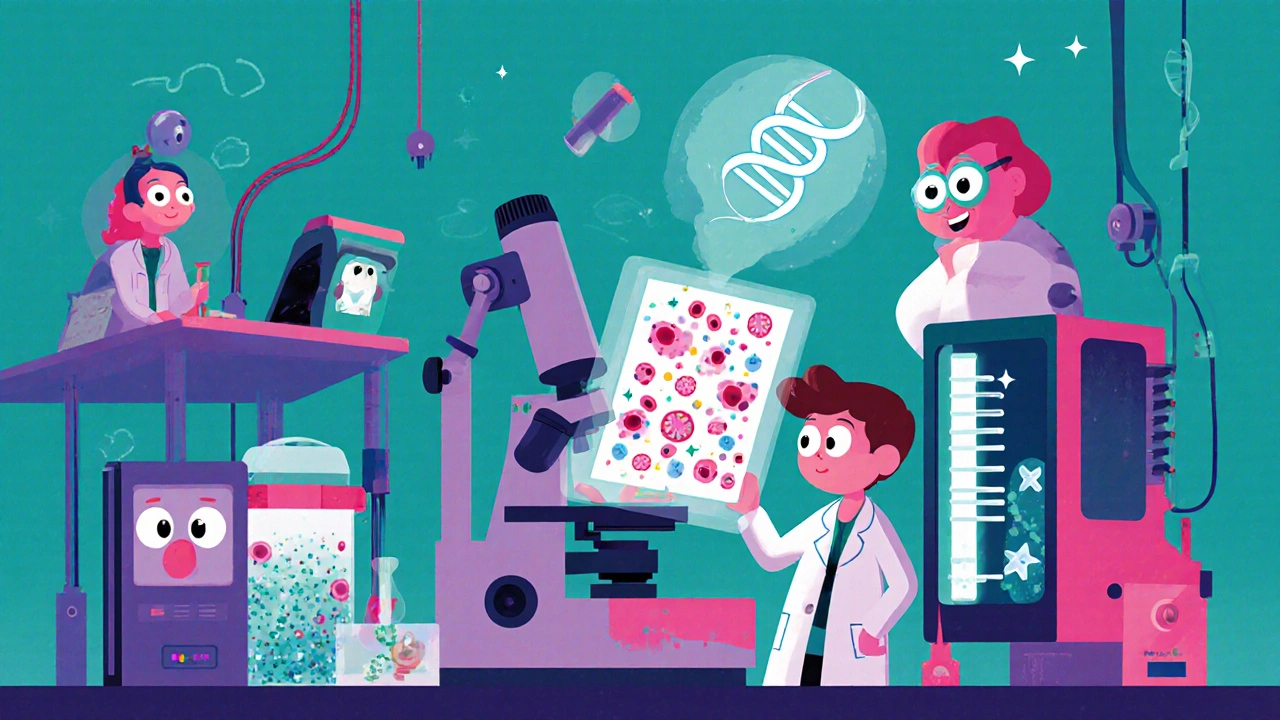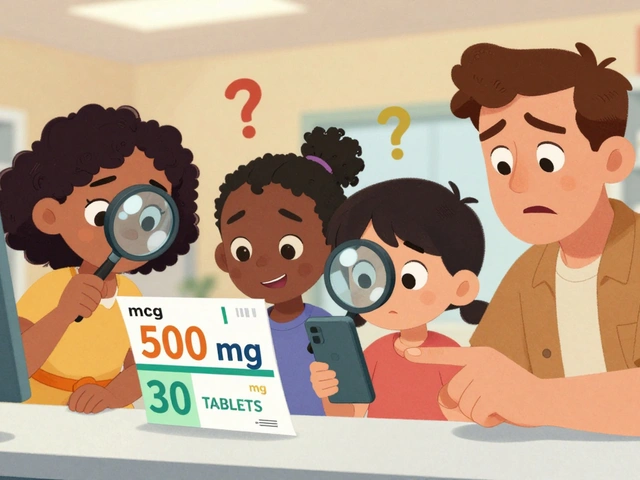How Bone Marrow Biopsies Aid Leukemia Diagnosis and Monitoring

Leukemia Monitoring Schedule Calculator
How This Tool Works
This calculator helps you understand the recommended timing for bone marrow biopsies during leukemia treatment based on your specific situation. It incorporates information from the article about monitoring disease response and Minimal Residual Disease (MRD) testing.
Why This Matters
Regular bone marrow biopsies are essential for assessing treatment response and guiding therapy adjustments. Without these monitoring steps, treatment may not be optimized for your specific disease.
Key Takeaways
- A bone marrow biopsy provides the most direct view of leukemia cells in the marrow.
- It works together with peripheral tests like flow cytometry to confirm subtype and track disease response.
- Modern techniques such as PCR and cytogenetics can be run on a single biopsy sample.
- Risks are low; pain is manageable and complications are rare.
- Regular biopsies are essential for assessing minimal residual disease (MRD) and guiding therapy adjustments.
When a doctor suspects leukemia, the first question is: bone marrow biopsy. This procedure lets clinicians look straight at the birthplace of blood cells and decide if cancerous clones are hiding there. Below we break down why the biopsy matters, what happens during the test, and how the results shape treatment from diagnosis through long‑term monitoring.
Bone marrow biopsy is a minimally invasive procedure that extracts a small core of marrow, usually from the hip bone, for laboratory analysis. The sample contains both solid tissue and liquid aspirate, giving pathologists a complete picture of cellular architecture, genetics, and disease burden. Because leukemia originates in the marrow, this direct evidence outweighs any clues you might get from blood alone.
Why Blood Tests Alone Aren’t Enough
Doctors often start with a Peripheral blood smear and a complete blood count (CBC). Those tests can flag abnormal white‑cell counts, anemia, or low platelets, but they don’t reveal the exact lineage or mutation driving the disease. For example, a high blast count could indicate either acute lymphoblastic leukemia (ALL) or acute myeloid leukemia (AML); both need very different chemotherapy protocols.
Flow cytometry adds another layer by measuring surface markers on individual cells. While powerful, it still relies on cells that have entered the bloodstream. Some leukemic cells stay locked in the marrow niche, evading detection. That’s why confirming the diagnosis with a biopsy is the gold standard.
What Happens During the Procedure
- After a local anesthetic, the clinician inserts a hollow needle into the posterior iliac crest.
- A small amount of liquid (aspirate) is drawn for cytological stains.
- The needle’s inner trocar then cores a solid piece of marrow (about 1‑2cm) for histology.
- The sample is placed in fixatives and sent to a hematopathology lab.
- Patients are observed for 30minutes; pain is usually brief and can be managed with over‑the‑counter analgesics.
Complications such as bleeding or infection occur in less than 1% of cases, making the biopsy a safe diagnostic tool for most patients, including children and the elderly.
Laboratory Analyses: From Morphology to Molecular Detail
The core biopsy undergoes several tests:
- Histopathology: Slides are stained (H&E, reticulin) to assess cellularity and fibrosis.
- Immunophenotyping via flow cytometry on the aspirate pinpoints lineage (B‑cell, T‑cell, myeloid).
- Cytogenetics (karyotype) reveals chromosomal translocations (e.g., t(9;22) Philadelphia chromosome).
- Polymerase chain reaction (PCR) detects specific gene fusions (BCR‑ABL1) and quantifies minimal residual disease (MRD).
- Next‑generation sequencing (NGS) can uncover mutations in FLT3, NPM1, or TP53 that guide targeted therapy.
Each test adds a piece to the diagnostic puzzle, enabling doctors to classify the leukemia accurately-whether it’s Acute lymphoblastic leukemia, Acute myeloid leukemia, or a chronic form like Chronic lymphocytic leukemia. The subtype dictates which chemotherapy agents, monoclonal antibodies, or newer kinase inhibitors will be most effective.

Monitoring Disease Progress: The Role of Serial Biopsies
Even after remission, doctors need to know whether any leukemic cells remain. This is where Minimal residual disease (MRD) testing shines. MRD can be measured by PCR or NGS on bone marrow aspirate, detecting one cancer cell among 10,000 to 100,000 normal cells.
Studies show that patients with MRD‑negative status after induction therapy have significantly longer disease‑free survival. If MRD persists, the treatment plan may be intensified-adding a second‑line agent or moving toward stem‑cell transplantation earlier.
Some clinicians use peripheral blood PCR for MRD in chronic leukemias, but marrow remains the most sensitive source for acute cases. A typical monitoring schedule looks like:
- Baseline biopsy at diagnosis.
- Day14-28 post‑induction biopsy to assess early response.
- End‑of‑consolidation biopsy (around month3‑4).
- Every 3‑6months during maintenance, especially if the patient had high‑risk cytogenetics.
Comparing Bone Marrow Biopsy with Alternative Sampling Methods
| Aspect | Bone Marrow Biopsy | Peripheral Blood Tests |
|---|---|---|
| Sensitivity for acute leukemias | >95% | ~70% |
| Ability to detect cytogenetic abnormalities | Full karyotype & FISH possible | Limited to circulating blasts |
| Invasiveness | Minimally invasive, local anesthesia | Non‑invasive (venipuncture) |
| Typical recovery time | 30‑60minutes observation | Immediate discharge |
| Cost (US$) | ~$2,200 (including labs) | ~$200 |
While blood tests are cheaper and easier, they can miss low‑level disease or subtle genetic changes that change treatment direction. The biopsy remains indispensable for a definitive diagnosis and precise MRD tracking.
Preparing Patients for a Comfortable Experience
Good preparation reduces anxiety and improves sample quality. Key tips:
- Hydration: Drink plenty of water the day before; it helps keep the marrow cavity slightly expanded.
- Medication review: Hold anticoagulants (e.g., warfarin) as instructed by the hematologist to minimize bleeding risk.
- Pain management plan: Discuss options like ibuprofen or acetaminophen post‑procedure.
- Support person: Having a friend or family member nearby can ease emotional stress.
Most patients report a brief, sharp sensation during needle insertion, followed by dull ache for a few hours. Applying a warm compress after the procedure can speed recovery.

Future Directions: Less Invasive but Equally Powerful
Researchers are exploring “liquid biopsy” techniques-using circulating tumor DNA (ctDNA) from blood to replace marrow sampling. Early trials in AML show ctDNA can detect mutations with 80‑85% concordance to bone marrow NGS. However, regulatory agencies still require marrow confirmation for initial diagnosis, and ctDNA lacks the ability to assess marrow cellularity or fibrosis.
Until liquid biopsies become fully validated, the bone marrow will stay the cornerstone of leukemia care. Ongoing advances in single‑cell sequencing and AI‑driven image analysis promise more precise risk stratification from each core sample.
Frequently Asked Questions
Frequently Asked Questions
How painful is a bone marrow biopsy?
Most patients describe a brief sharp pressure when the needle penetrates the bone, followed by a dull ache for a few hours. Over‑the‑counter pain relievers usually control any discomfort.
Can a biopsy be done on children?
Yes. Pediatric hematologists use the same technique, often with a child‑life specialist present to reduce anxiety. Complication rates are similar to adults.
How often should I get a follow‑up biopsy?
Typical schedules include a post‑induction biopsy (2‑4weeks), an end‑of‑consolidation biopsy (3‑4months), and then every 3‑6months during maintenance, especially if you have high‑risk genetics.
What if the biopsy shows no cancer cells?
A negative result usually means remission, but doctors will still monitor blood counts and may repeat MRD testing to confirm no residual disease.
Are there alternatives to bone marrow biopsy?
Liquid biopsies (circulating DNA) are promising but still experimental. For definitive diagnosis and detailed genetic profiling, the marrow remains the gold standard.
Understanding the why and how of bone marrow biopsies empowers patients and families to ask the right questions, stay on top of treatment milestones, and feel more in control of a complex disease.






Emily Rankin
October 17, 2025 AT 18:00When we stare into the marrow, we are really looking into the very crucible of life, where the brave dance of blood cells begins and sometimes falters.
Each tiny core that the needle retrieves is a silent storyteller, whispering the hidden chapters of a disease that can feel like a dark storm.
Yet within that storm there is a glimmer of hope, because knowledge is the lantern that guides us through the night.
The biopsy gives doctors a front‑row seat to the battlefield, allowing them to map the enemy’s weapons down to the genetic level.
With this map, treatments become precision arrows rather than blunt force.
It is astonishing how a single centimeter of tissue can unlock a cascade of tests-flow cytometry, PCR, NGS-that together paint a vivid portrait of the malignancy.
Patients often fear the needle, but the brief pinch is a small price for the exquisite clarity that follows.
When remission is declared, the journey does not end; a series of follow‑up biopsies become the compass that ensures the disease stays buried.
Minimal residual disease detection is the unsung hero, catching rogue cells before they regrow their empire.
Studies show that MRD‑negative status after induction translates into longer, more peaceful lives for survivors.
Imagine a world where every relapse could be nipped in the bud because we never stopped listening to the marrow’s tale.
The procedure’s safety profile is reassuring-less than one percent face serious complications, and most walk out with just a dull ache.
Rebecca Mitchell
October 18, 2025 AT 17:06Bone marrow biopsies are just another step forward
Roberta Makaravage
October 19, 2025 AT 16:13Honestly, anyone who skips a bone marrow biopsy is basically playing roulette with their health 😒.
The science is crystal clear: without that core sample you miss the genetic nuances that dictate therapy.
Honestly, it’s not just about spotting blasts, it’s about catching the silent mutations that whisper relapse.
People love to romanticize “natural healing,” but in leukemia you need hard data, not wishful thinking.
Respect the process, get the biopsy, and let the oncologist do their job 🙅♀️.
Lauren Sproule
October 20, 2025 AT 15:20i totally get where you're coming from but i think we can keep it friendly and supportive here
the biopsy is definitely a tool not a punishment and many folks feel better after knowing exactly what’s going on
lets remember that everyone’s journey is unique and a little kindness goes a long way
CHIRAG AGARWAL
October 21, 2025 AT 14:26Why do we have to make such a big deal out of a simple needle poke? It’s not like it’s a surgery.
People act like it’s the end of the world when it’s just a routine step.
genevieve gaudet
October 22, 2025 AT 13:33hey chirag i feel u but think it’s kinda deep how the marrow holds stories of our ancestors and cultures too
in many traditions, blood is seen as the river of life, so examining its source can be a profound ritual
maybe we can view the biopsy as a bridge between modern science and those timeless beliefs
Virginia Dominguez Gonzales
October 23, 2025 AT 12:40Let’s keep the momentum up – you’ve already taken the brave step of learning about the biopsy, now channel that courage into your appointments.
Remember, the medical team wants to empower you, not intimidate you.
Bring a friend, ask for a clear pain plan, and celebrate each small milestone, even if it’s just a painless recovery day.
Your resilience is a powerful ally, and every piece of data from the marrow helps tailor a fight plan that’s uniquely yours.
Stay strong, stay hopeful, and keep asking for the information you deserve.
Carissa Padilha
October 24, 2025 AT 11:46Sure, they say it’s safe, but have you ever wondered who’s really tracking those complication stats?
Sometimes the data feels curated, like the industry is hiding hidden side effects in the shadows.
Just saying, stay vigilant and keep questioning everything.